Cardboard boat races put teamwork and learning to the test
By Al Beeber - Lethbridge Herald on November 17, 2023.
 Herald photo by Ian Martens
The LCI team of Berkley Manser, Madeline Drummond, Charlotte Fink and Camryn Veurink react as their ship goes down in the weight-bearing portion of the annual Cardboard Boat Races on Thursday at the University of Lethbridge pool.
Herald photo by Ian Martens
The LCI team of Berkley Manser, Madeline Drummond, Charlotte Fink and Camryn Veurink react as their ship goes down in the weight-bearing portion of the annual Cardboard Boat Races on Thursday at the University of Lethbridge pool.LETHBRIDGE HERALDabeeber@lethbridgeherald.com
They designed, constructed and hopefully crewed a cardboard boat across the pool without capsizing or watching their craft fall apart.
Students from numerous schools across southwestern Alberta on Thursday worked as teams in the Career Transitions annual cardboard boat race at the 1st Choice Savings Centre for Sport and Wellness at the University of Lethbridge.
The 50 teams comprised of 200 students working in teams of four, had 90 minutes to construct their boats of cardboard, duct tape and packing tape before hitting the water with one member of each team piloting their craft across the pool.
Teams are also given a surprise item to incorporate into construction which can be almost anything. Two years ago, that item was a pool noodle and last year a table cloth, which enterprising teams used to protect the bottom of boats.
The goal of the project was for students to practice communication and problem-solving skills while applying their knowledge of principles related to buoyancy and displacement, water permeability and structure as well as strength and rigidity.
The day featured 11 teams in the high school division and 39 in the middle school division.
Teams were judged on numerous factors including design, construction and weight-bearing capacity of their crafts.
Judy Stolk-Ingram of Career Transitions said before the event that “teamwork skills, those are skills that are so important across the board – no matter where people go, end up working or even helping them to get through post-secondary. Those teamwork and communication and leadership skills are essential.”
She said teachers she has talked to have said how interesting it is to see how different students rise to the occasion in such an environment.
“It’s not the traditional learning environment, there’s not 30 students in a room so in that small group, it does give the chance for kids to really shine,’ said Stolk-Ingram.
Teams were required to submit a drawing of their design in advance of the judging.
“What kind of thought did the students put into this? We actually have some of our schools that have incorporated a cardboard boat race course into their curriculum at the middle school level. The awesome people at G.S. Lakie got that rolling and have very generously shared the curriculum with other schools that are interested,” she said.
“There’s a lot of science and physics to this,’ she added.
Whether the boat makes it across or not students will still learn from the experience, she said.
After boats crossed the pool, the weight-bearing challenge came into play. There has to be three team members with all appendages in the boat and if they floated for a second, they got partial points. Ultimately, they needed to float for a minute to get full points.
“Ultimately we like the fact there’s an element of competition but we also really appreciate the fact students are learning so much and having a blast at the same time,” said Stolk-Ingram.
Teams aren’t allowed to consult with their teacher during construction but instructors play an important and pivotal role in the competition.
“They are preparing students, they are making sure that they’ve got those key principles, they are making sure that students understand what the goal is. We actually have some schools that have a competition internally. Career Transitions, through our supplier, we often will buy extra cardboard if a school will request it.”
Some students have competed four or five years in a row and it shows, she said.
Those are the students who have a passion for design, engineering and construction.
“If we can provide this venue, this opportunity for them to apply those principles in real life, if we can give those kids the opportunity to have that connection with the engineers and the technologists and the architects and all those creative design people we bring in to do the judging, it’s really trying to help formulate who they are and where their strengths and talents are in hopes that they can use that information to make decisions as they move through high school in terms of their course selection, but also when they start to consider different post-secondary options,” Stolk-Ingram added.
Career Transitions is a charitable organization that has partnerships with six school divisions in southwestern Alberta.
“Our mission really is to provide a range of programs and events that can help introduce kids to different business and industry professionals, introduce them to different occupations and career pathways. We want students to have this variety of experiences before they make any decisions about what they’re going to do after high school,” said Stolk-Ingram.
Follow @albeebHerald on Twitter
26-25




